On-Line Compensation for Micromilling of High-Aspect-Ratio Straight Thin Walls
Abstract
:1. Introduction
2. Thin Wall Deformation Mechanism and Compensation Device
2.1. Thin Wall Deformation Mechanism
2.2. Cutting Force Measurement and Cutting Parameter Compensation Device
3. Finite Element Simulation
3.1. Simulation Model
3.2. Cutting Parameters Selection
3.3. Simulation Result and Analysis
3.4. Simulation for Radial Cutting Parameter Compensation
4. Experiment
4.1. Contrast Experiment Setup
4.2. Results and Analyses
4.3. Optimization Experiment Setup
4.4. Optimization Results and Analyses
5. Conclusions
Author Contributions
Funding
Institutional Review Board Statement
Informed Consent Statement
Data Availability Statement
Acknowledgments
Conflicts of Interest
References
- Chen, W.F.; Lou, P.H.; Chen, H. Active compensation methods of machining deformation of thin-walled parts. Acta Aeronaut. Astronaut. Sin. 2009, 30, 570–576. [Google Scholar]
- Lim, E.M.; Meng, C.H.; Yen, D.W. Integrated planning for precision machining of complex surfaces—III compensation of dimensional errors. Int. J. Mach. Tools Manuf. 1997, 37, 1313–1326. [Google Scholar]
- Lim, E.M.; Meng, C.H. Integrated planning for precision machining of complex surfaces. Part 1: Cutting-path and feedrate optimization. Int. J. Mach. Tools Manuf. 1997, 37, 61–75. [Google Scholar]
- Cho, M.W.; Seo, T.I.; Kwon, H.D. Integrated error compensation method using OMM system for profile milling operation. J. Mater. Process. Technol. 2003, 136, 88–99. [Google Scholar] [CrossRef]
- Cho, M.W.; Kim, G.H.; Seo, T.I.; Hong, Y.C.; Cheng, H.H. Integrated machining error compensation method using OMM data and modified PNN algorithm. Int. J. Mach. Tools Manuf. 2006, 46, 1417–1427. [Google Scholar] [CrossRef]
- Ratchev, S.; Liu, S.; Becker, A.A. Error compensation strategy in milling flexible thin-wall parts. J. Mater. Process. Technol. 2005, 162–163, 673–681. [Google Scholar] [CrossRef]
- Chen, W.F.; Xue, J.B.; Tang, D.B.; Chen, H.; Qu, S. Deformation prediction and error compensation in multilayer milling processes for thin-walled parts. Int. J. Mach. Tools Manuf. 2009, 49, 859–864. [Google Scholar] [CrossRef]
- Song, G. Research on Surface Error Prediction in Milling Process of Thin Wall Part Based on Accurate Cutting Force Modeling; Shandong University: Jinan, China, 2012. [Google Scholar]
- Cao, Y.; Bai, Y.; He, Y.; Tian, J.; Li, Y. NC milling deformation forecasting of aluminum alloy thin-walled workpiece based on orthogonal cutting experiments and CAD/CAM/FEA integration paper title. Int. J. Control Autom. 2014, 7, 67–80. [Google Scholar] [CrossRef]
- Bolar, G.; Joshi, S.N. 3D finite element modeling of thin-wall machining of aluminum 7075-T6 alloy. In Proceedings of the 5th International & 26th All India Manufacturing Technology, Design and Research Conference (AIMTDR 2014), Guwahati, Assam, India, 12–14 December 2014; pp. 135–141. [Google Scholar]
- Huang, N.D.; Bi, Q.Z.; Wang, Y.H.; Sun, C. 5-axis adaptive flank milling of flexible thin-walled parts based on the on-machine measurement. Int. J. Mach. Tools Manuf. 2014, 84, 1–8. [Google Scholar] [CrossRef]
- Kant, R.; Joshi, S.N.; Dixit, U.S. An integrated FEM-ANN model for laser bending process with inverse estimation of absorptivity. Mech. Adv. Mater. Mod. Process. 2015, 1, 6. [Google Scholar] [CrossRef] [Green Version]
- Ratchev, S.; Liu, S.; Huang, W.; Becker, A.A. An advanced FEA based force induced error compensation strategy in milling. Int. J. Mach. Tools Manuf. 2016, 46, 542–551. [Google Scholar] [CrossRef]
- Hou, Y.H.; Zhang, D.H.; Zhang, Y. Error compensation modeling and learning control method for thin-walled part milling process. J. Mech. Eng. 2018, 54, 109–115. [Google Scholar] [CrossRef]
- Yi, J.; Xiang, J.F.; Yi, F.Y.; Zhao, Y.; Wang, X.; Jiao, L.; Kang, Q. Prediction of mesoscale deformation in milling micro thin wall based on cantilever boundary. Int. J. Adv. Manuf. Technol. 2020, 106, 2875–2892. [Google Scholar] [CrossRef]
- Cheng, X.; Wei, X.T.; Yang, X.H.; Guo, Y.B. Unified criterion for brittle–ductile transition in mechanical microcutting of brittle materials. J. Manuf. Sci. Eng. Trans. ASME. 2014, 136, 051013. [Google Scholar] [CrossRef]
- Cheng, X.; Liu, J.C.; Zheng, G.M.; Yang, X.; Tian, Y. Study of micro-cutting fundamentals for peripheral and end cutting edges in micro-end-milling. J. Micromech. Microeng. 2018, 28, 015011. [Google Scholar] [CrossRef]
- Cheng, X.; Li, L.; Huang, Y.M.; Yang, X.; Zhou, S. Theoretical modeling of the critical conditions for ductile-regime milling of single crystalline silicon. Proc. Inst. Mech. Eng. Part C J. Mech. Eng. Sci. 2015, 229, 1462–1469. [Google Scholar] [CrossRef]
- Wang, F.; Cheng, X.; Guo, Q.J.; Yang, X.; Zheng, G. Experimental study on micromilling of thin walls. J. Micromech. Microeng. 2019, 29, 015009. [Google Scholar] [CrossRef]
- Wang, F.; Cheng, X.; Zheng, G.M.; Yang, X.; Guo, Q.J.; Sun, Q.L. Study of micromilling parameters and processes for thin wall fabrications. Precis. Eng. 2019, 56, 246–254. [Google Scholar] [CrossRef]
- Li, Y.; Cheng, X.; Ling, S.Y.; Zheng, G.; Liu, H.; Wang, F. Study on micro cutting fundamentals considering the cutting edge radius and the workpiece material in micro end milling. Proc. Inst. Mech. Eng. Part E J. Process. Mech. Eng. 2021, 235, 93–102. [Google Scholar] [CrossRef]
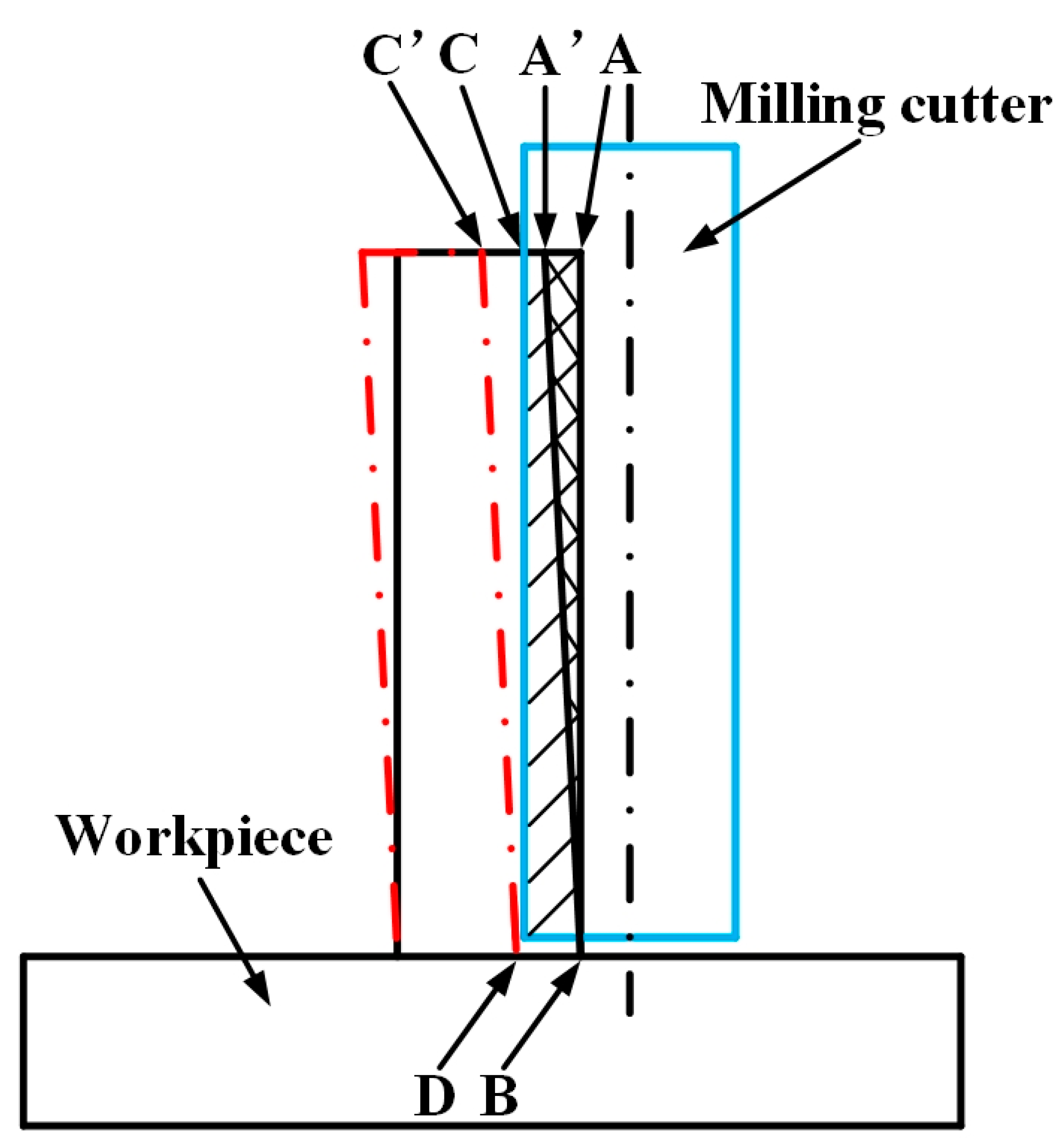

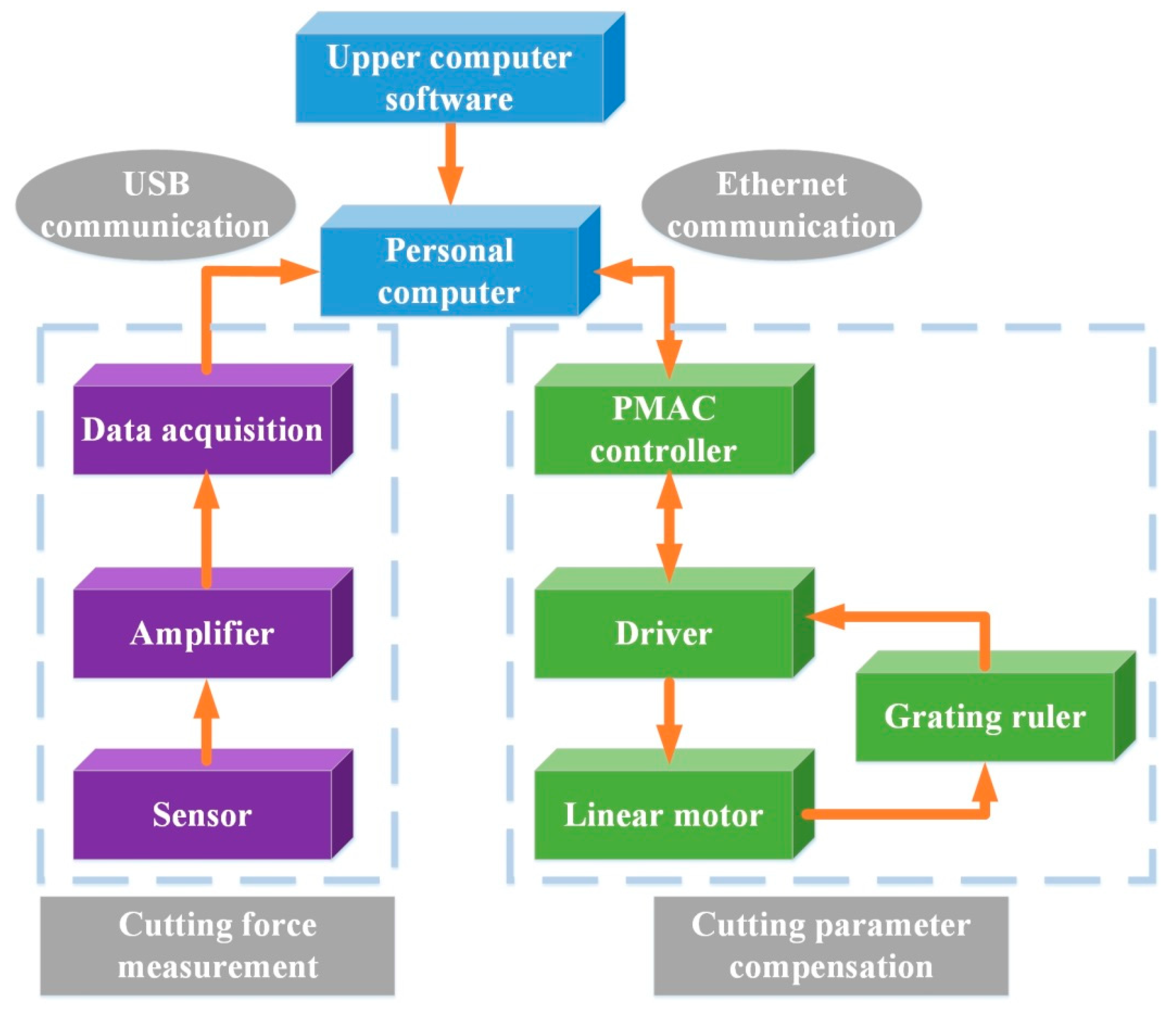

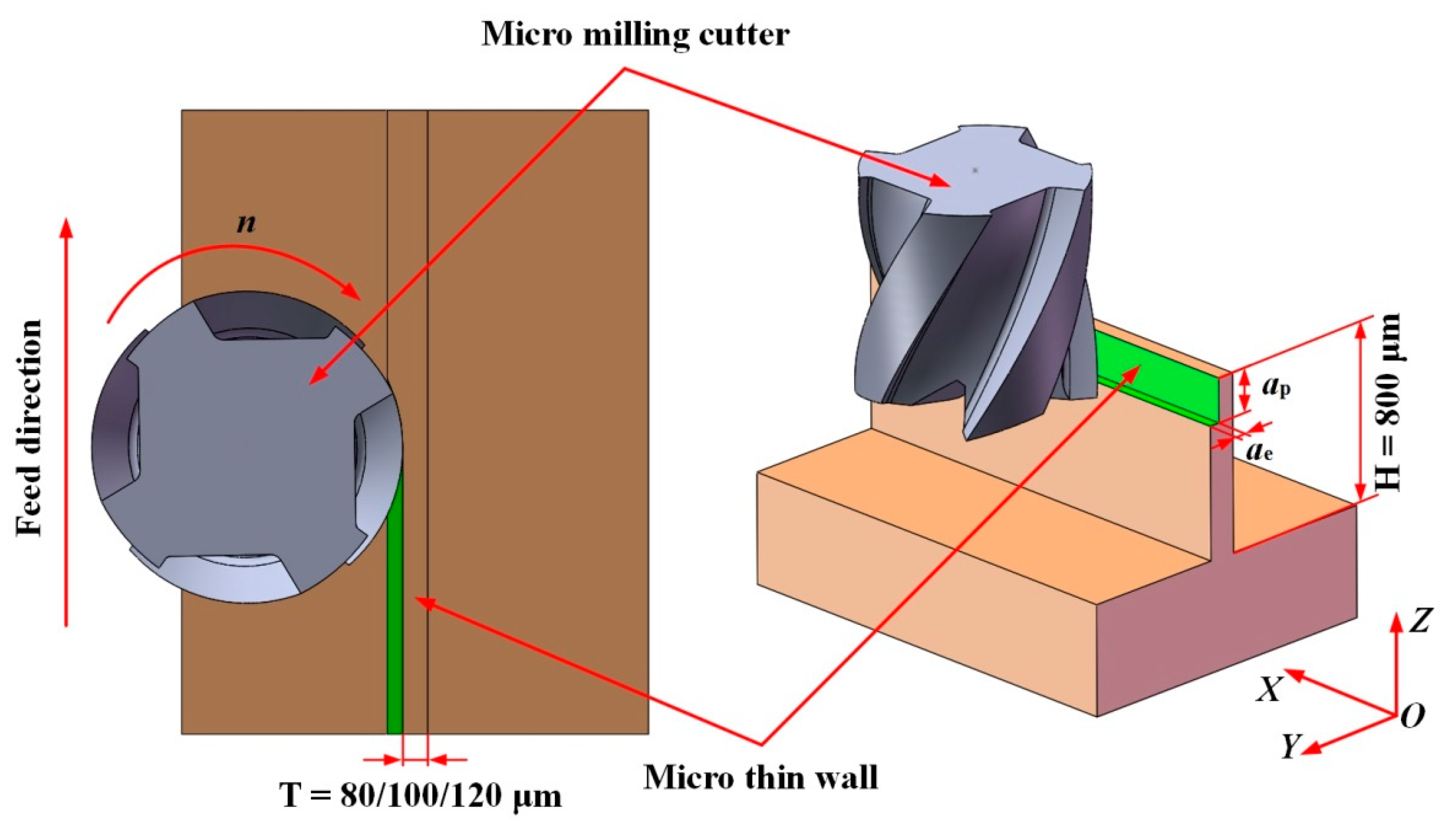


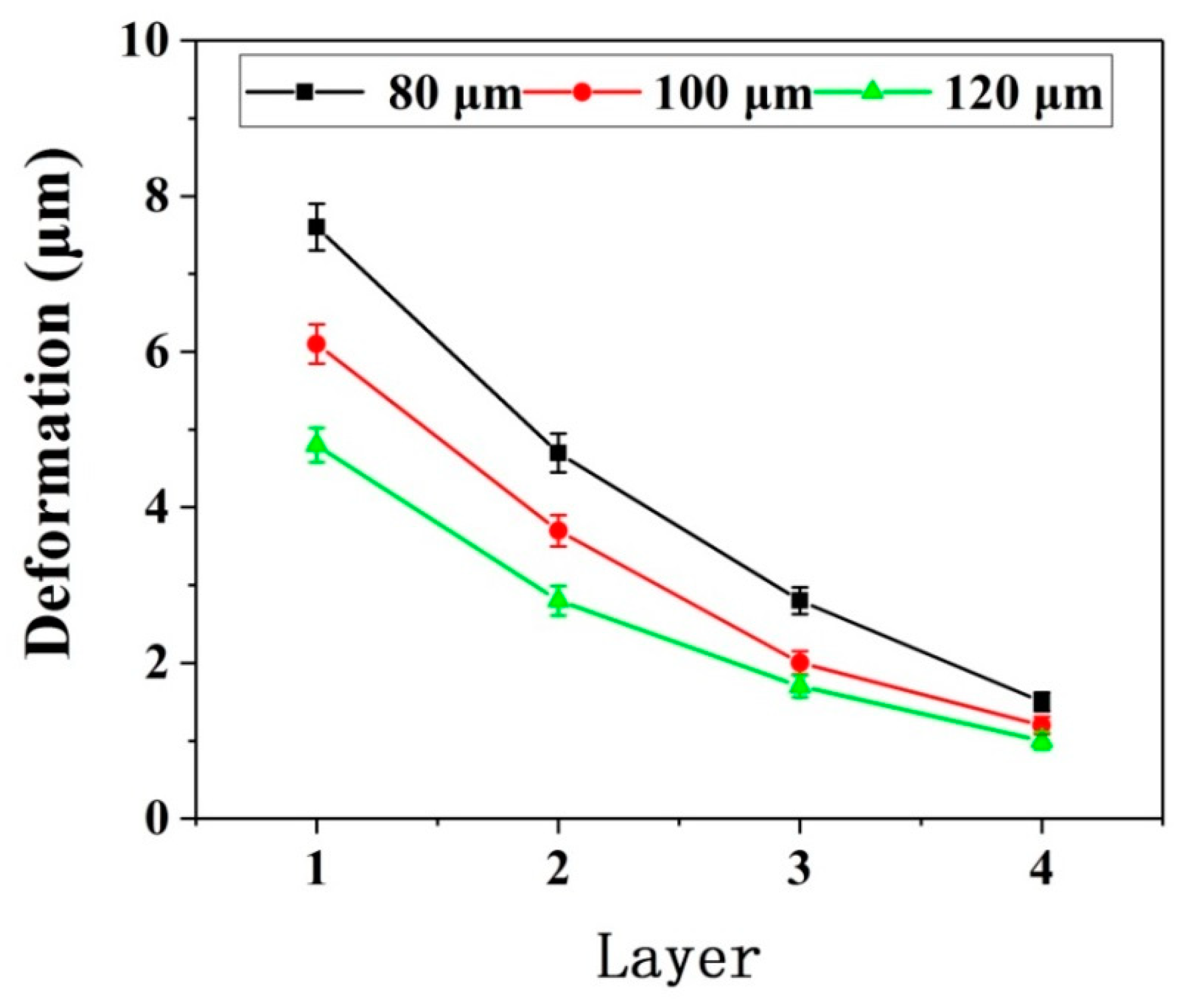

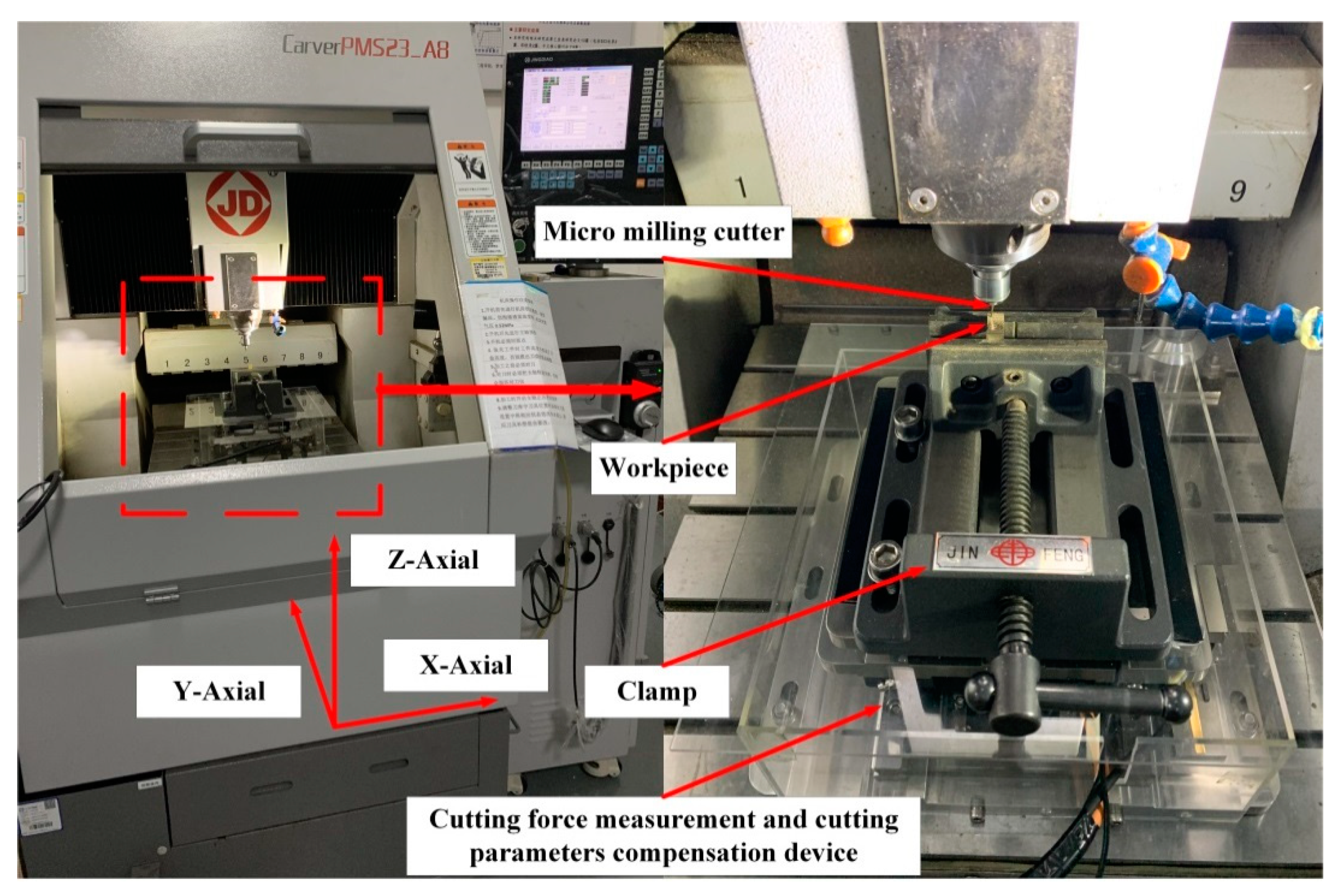
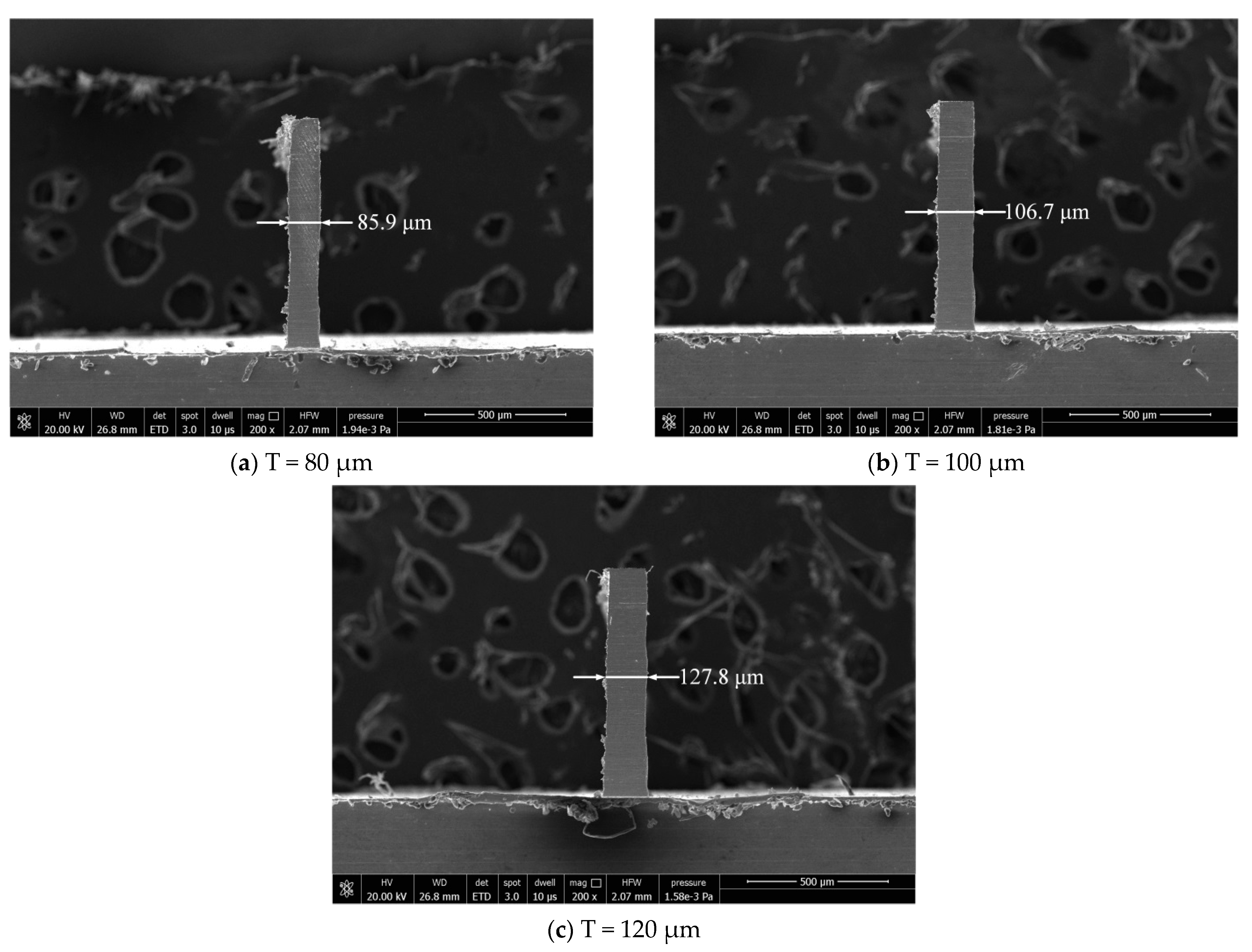

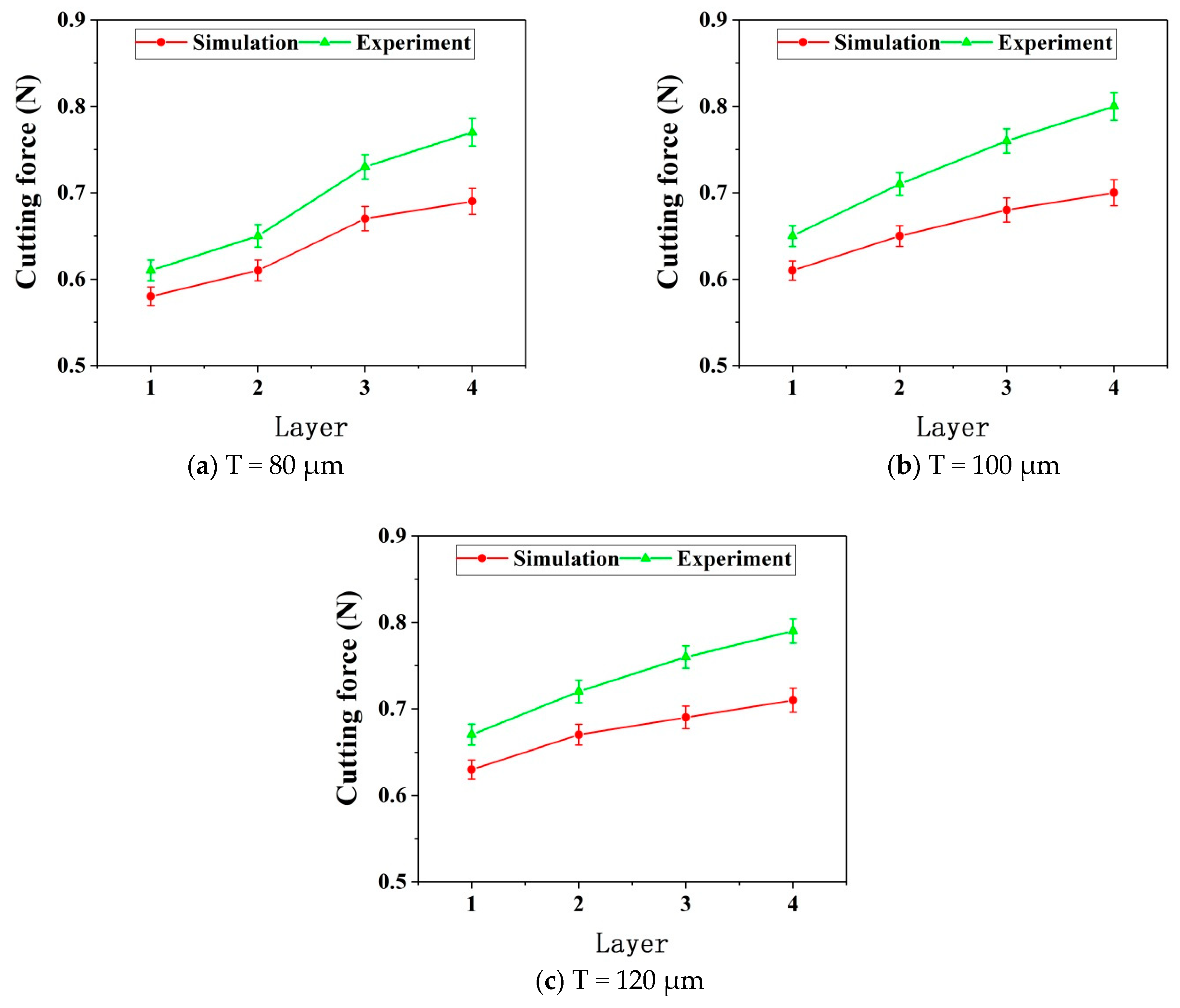
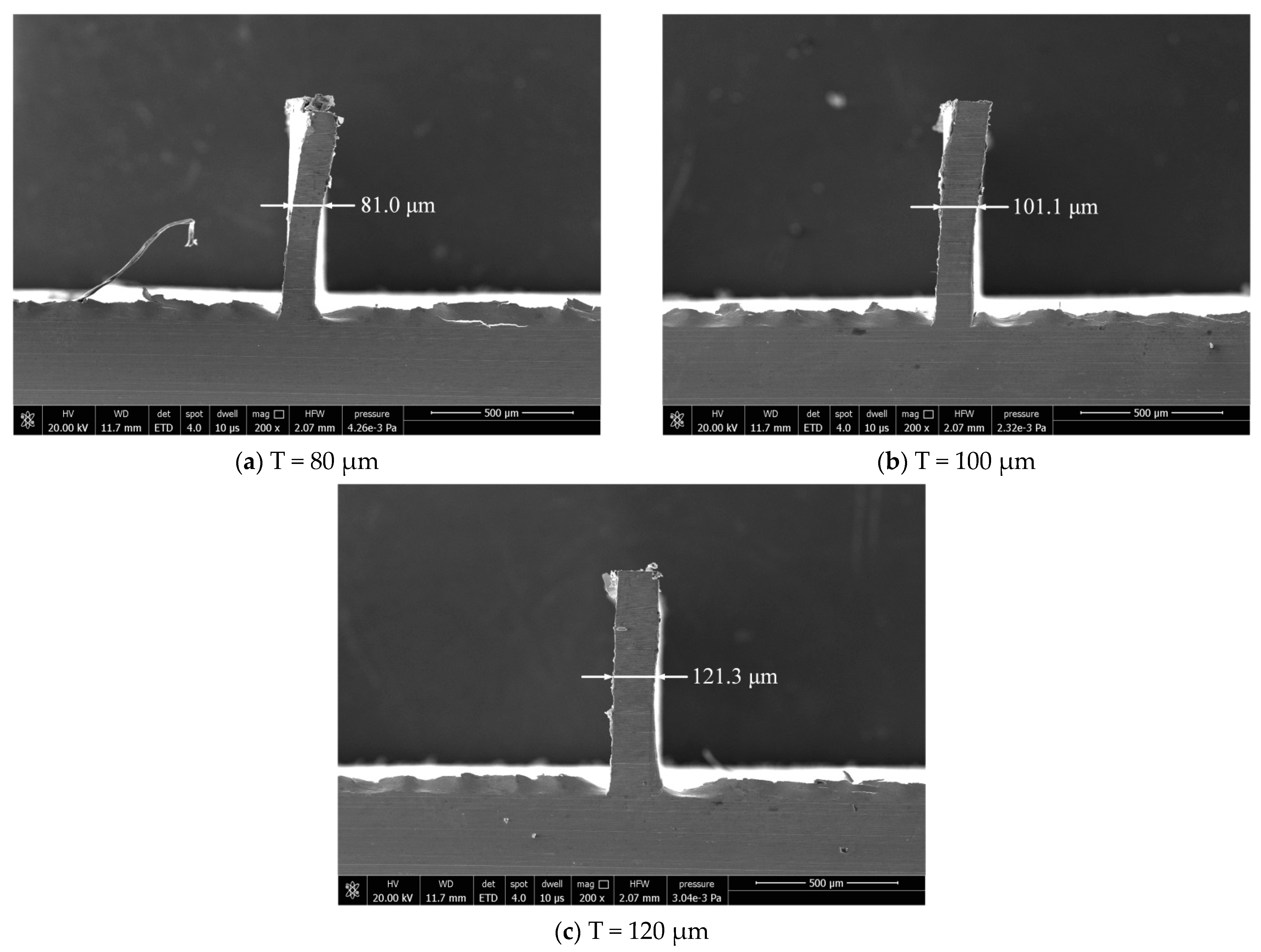
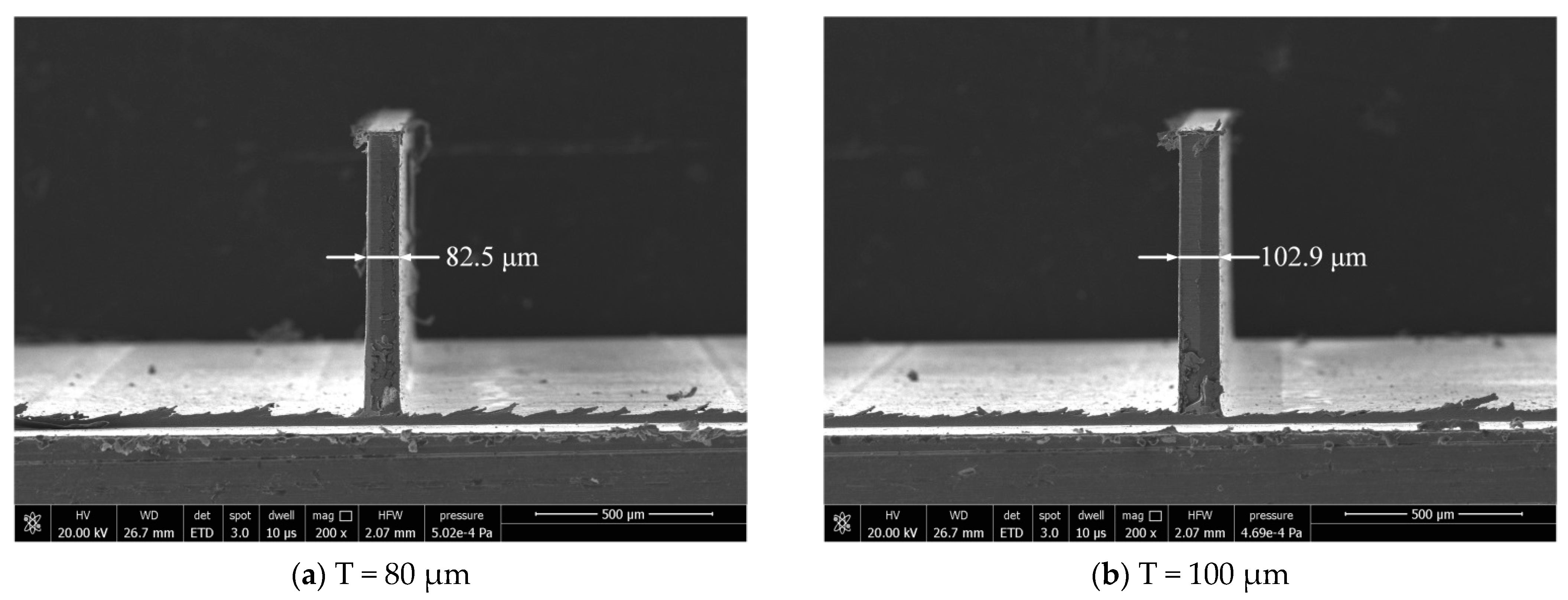
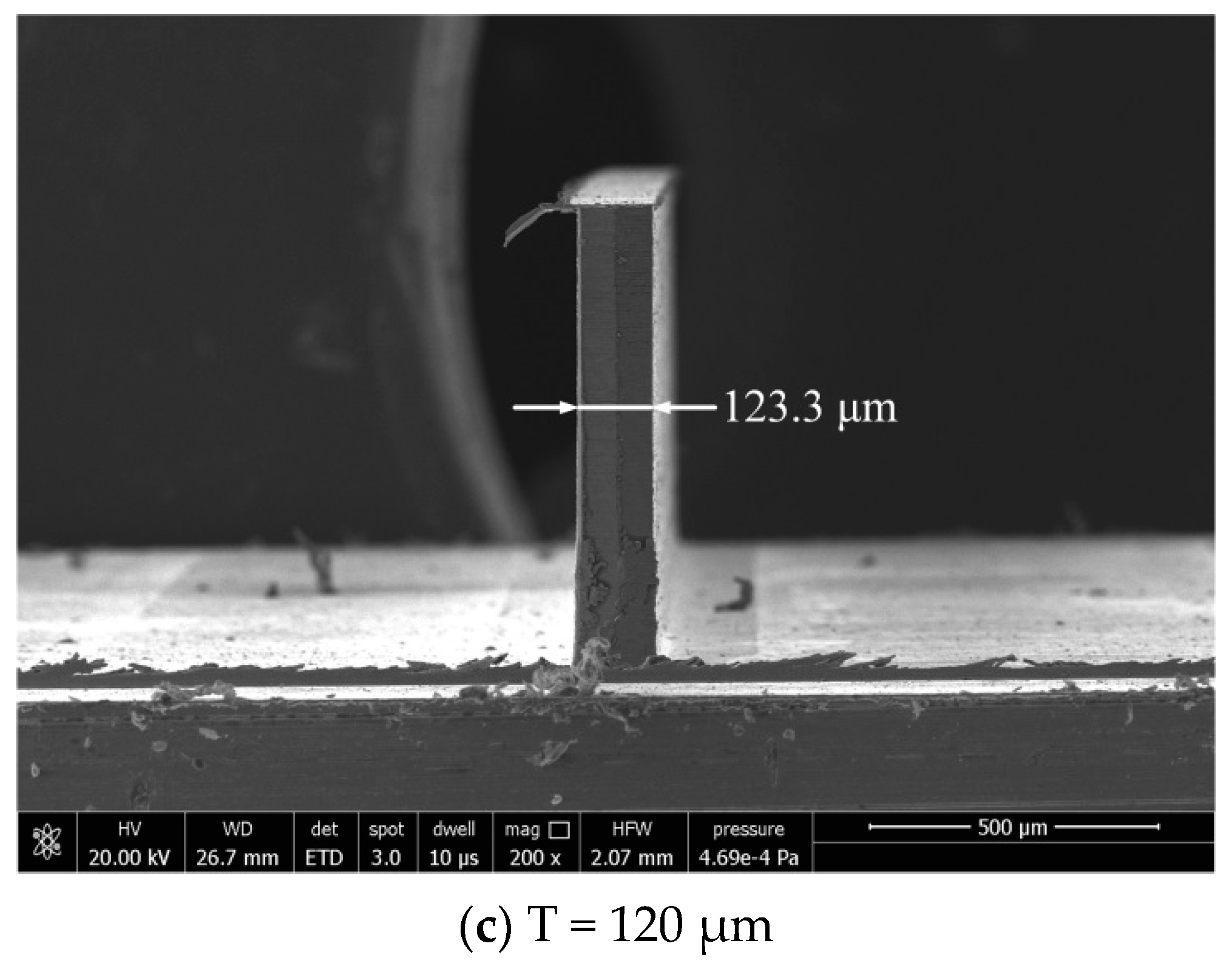
| Diameter | Spiral Angle | Cutting Edges | Cutting Edge Radius | Matrix | Coating | Tool Length |
|---|---|---|---|---|---|---|
| 1 mm | 35° | 4 | 5 μm | Carbide | TiAlN | 50 mm |
| Material | Elastic Modulus (N/mm2) | Shear Elastic Modulus (N/mm2) | Poisson Ratio | Thermal Conductivity (W/(m·K)) | Specific Heat (J/(kg·K)) | Density (Kg/m3) |
|---|---|---|---|---|---|---|
| H59 Brass | 100,000 | 37,593 | 0.33 | 110 | 390 | 8500 |
| No. | T (μm) | H (μm) | ae (μm) | ap (μm) | fz (μm/z) | n (rpm) |
|---|---|---|---|---|---|---|
| 1 | 80 | |||||
| 2 | 100 | 800 | 50 | 200 | 1.6 | 20,000 |
| 3 | 120 |
| Compensation Step | Layer | ||||
|---|---|---|---|---|---|
| 1 | 2 | 3 | 4 | ||
| No compensation | Average peak force (N) | 0.58 | 0.61 | 0.67 | 0.69 |
| Deformation (μm) | 7.6 | 4.7 | 2.8 | 1.5 | |
| First compensation | Radial compensation (μm) | 7.6 | 4.7 | 2.8 | 1.5 |
| Average peak force (N) | 0.67 | 0.69 | 0.70 | 0.71 | |
| Added deformation (μm) | 2.6 | 1.9 | 1.2 | 0.7 | |
| Second compensation | Radial compensation (μm) | 2.6 | 1.9 | 1.2 | |
| Average peak force (N) | 0.70 | 0.71 | 0.72 | ||
| Added deformation (μm) | 1.2 | 0.9 | 0.5 | ||
| Third compensation | Radial compensation (μm) | 1.2 | |||
| Average peak force (N) | 0.73 | ||||
| Added deformation (μm) | 0.5 | ||||
| Compensation Step | Layer | ||||
|---|---|---|---|---|---|
| 1 | 2 | 3 | 4 | ||
| No compensation | Average peak force (N) | 0.61 | 0.65 | 0.68 | 0.70 |
| Deformation (μm) | 6.1 | 3.7 | 2.0 | 1.2 | |
| First compensation | Radial compensation (μm) | 6.1 | 3.7 | 2.0 | 1.2 |
| Average peak force (N) | 0.68 | 0.70 | 0.70 | 0.71 | |
| Added deformation (μm) | 2.1 | 1.3 | 0.9 | 0.5 | |
| Second compensation | Radial compensation (μm) | 2.1 | 1.3 | ||
| Average peak force (N) | 0.70 | 0.72 | |||
| Added deformation (μm) | 1.1 | 0.7 | |||
| Third compensation | Radial compensation (μm) | 1.1 | |||
| Average peak force (N) | 0.73 | ||||
| Added deformation (μm) | 0.5 | ||||
| Compensation Step | Layer | ||||
|---|---|---|---|---|---|
| 1 | 2 | 3 | 4 | ||
| No compensation | Average peak force (N) | 0.63 | 0.67 | 0.69 | 0.71 |
| Deformation (μm) | 4.8 | 2.8 | 1.7 | 1.0 | |
| First compensation | Radial compensation (μm) | 4.8 | 2.8 | 1.7 | 1.0 |
| Average peak force (N) | 0.69 | 0.70 | 0.71 | 0.72 | |
| Added deformation (μm) | 1.7 | 1.0 | 0.7 | 0.5 | |
| Second compensation | Radial compensation (μm) | 1.7 | 1.0 | ||
| Average peak force (N) | 0.72 | 0.73 | |||
| Added deformation (μm) | 0.8 | 0.5 | |||
| No. | Thin Wall Thickness (μm) | Thin Wall Thickness without Compensation (μm) | Relative Dimensional Errors | Thin Wall Thickness with Compensation (μm) | Relative Dimensional Errors |
|---|---|---|---|---|---|
| 1 | 80 | 85.9 | 7.4% | 81.6 | 2.0% |
| 2 | 100 | 106.7 | 6.7% | 101.9 | 1.9% |
| 3 | 120 | 127.8 | 6.5% | 122.4 | 2.0% |
| Average | 100 | 107.2 | 6.9% | 102.0 | 2.0% |
| Thin Wall Thickness (μm) | Added Deformation Interval (μm) | Add Deformation (μm)/Radial Compensation (μm)/Critical Cutting Force (N) | |||
|---|---|---|---|---|---|
| 1st Layer | 2nd Layer | 3rd Layer | 4th Layer | ||
| (0.1, 0.5) | 0.1/11.9/0.74 | 0.2/7.5/0.73 | 0.1/4.3/0.73 | 0.1/2.2/0.72 | |
| 80 | (0.5, 0.9) | 0.5/11.4/0.73 | 0.9/6.6/0.71 | 0.5/3.8/0.72 | 0.7/1.5/0.71 |
| (0.9, 1.3) | 1.2/10.2/0.70 | 1.2/3.9/0.66 | 1.2/2.6/0.70 | ↑ | |
| (0.1, 0.5) | 0.1/9.8/0.75 | 0.2/5.7/0.74 | 0.2/2.9/0.72 | 0.1/1.7/0.72 | |
| 100 | (0.5, 0.9) | 0.5/9.3/0.73 | 0.7/5.0/0.72 | 0.9/2.0/0.70 | 0.5/1.2/0.71 |
| (0.9, 1.3) | 1.1/8.2/0.70 | 1.3/3.7/0.70 | ↑ | ↑ | |
| (0.1, 0.5) | 0.2/7.3/0.74 | 0.1/4.3/0.74 | 0.1/2.4/0.72 | 0.1/1.5/0.73 | |
| 120 | (0.5, 0.9) | 0.8/6.5/0.72 | 0.5/3.8/0.73 | 0.7/1.7/0.71 | 0.5/1.0/0.72 |
| (0.9, 1.3) | 1.2/3.9/0.66 | 1.0/2.8/0.70 | ↑ | ↑ | |
| Added Deformation Interval (μm) | Thin Wall Thickness (μm) | ||
|---|---|---|---|
| 80 | 100 | 120 | |
| (0.1, 0.5) | ★ | ★★ | ★★ |
| (0.5, 0.9) | ★★★ | ★★★ | ★★★ |
| (0.9, 1.3) | ★★★ | ★★★ | ★★★ |
| Added Deformation Interval (μm) | Thin Wall Thickness (μm) | ||
|---|---|---|---|
| 80 | 100 | 120 | |
| (0.1, 0.5) | 1.0% | 1.1% | 1.2% |
| (0.5, 0.9) | 2.0% | 1.9% | 2.0% |
| (0.9, 1.3) | 3.0% | 2.9% | 3.1% |
Publisher’s Note: MDPI stays neutral with regard to jurisdictional claims in published maps and institutional affiliations. |
© 2021 by the authors. Licensee MDPI, Basel, Switzerland. This article is an open access article distributed under the terms and conditions of the Creative Commons Attribution (CC BY) license (https://creativecommons.org/licenses/by/4.0/).
Share and Cite
Li, Y.; Cheng, X.; Ling, S.; Zheng, G. On-Line Compensation for Micromilling of High-Aspect-Ratio Straight Thin Walls. Micromachines 2021, 12, 603. https://doi.org/10.3390/mi12060603
Li Y, Cheng X, Ling S, Zheng G. On-Line Compensation for Micromilling of High-Aspect-Ratio Straight Thin Walls. Micromachines. 2021; 12(6):603. https://doi.org/10.3390/mi12060603
Chicago/Turabian StyleLi, Yang, Xiang Cheng, Siying Ling, and Guangming Zheng. 2021. "On-Line Compensation for Micromilling of High-Aspect-Ratio Straight Thin Walls" Micromachines 12, no. 6: 603. https://doi.org/10.3390/mi12060603






